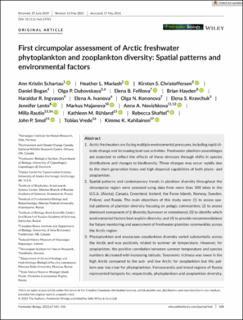First circumpolar assessment of Arctic freshwater phytoplankton and zooplankton diversity: Spatial patterns and environmental factors
Schartau, Ann Kristin; Mariash, Heather L.; Christoffersen, Kirsten Seestern; Bogan, Daniel; Dubovskaya, Olga P.; Fefilova, Elena B.; Hayden, Brian; Ingvason, Haraldur R.; Ivanova, Elena A.; Kononova, Olga N.; Kravchuk, Elena S.; Lento, Jennifer; Majaneva, Markus; Novichkova, Anna A.; Rautio, Milla; Rühland, Kathleen M.; Shaftel, Rebecca; Smol, John P.; Vrede, Tobias; Kahilainen, Kimmo K.
Peer reviewed, Journal article
Published version

View/
Date
2021Metadata
Show full item recordCollections
- Publikasjoner fra CRIStin - NINA [2364]
- Scientific publications [1392]
Abstract
1. Arctic freshwaters are facing multiple environmental pressures, including rapid climate change and increasing land-use activities. Freshwater plankton assemblages are expected to reflect the effects of these stressors through shifts in species distributions and changes to biodiversity. These changes may occur rapidly due to the short generation times and high dispersal capabilities of both phyto- and zooplankton. 2. Spatial patterns and contemporary trends in plankton diversity throughout the circumpolar region were assessed using data from more than 300 lakes in the U.S.A. (Alaska), Canada, Greenland, Iceland, the Faroe Islands, Norway, Sweden, Finland, and Russia. The main objectives of this study were: (1) to assess spatial patterns of plankton diversity focusing on pelagic communities; (2) to assess dominant component of β diversity (turnover or nestedness); (3) to identify which environmental factors best explain diversity; and (4) to provide recommendations for future monitoring and assessment of freshwater plankton communities across the Arctic region. 3. Phytoplankton and crustacean zooplankton diversity varied substantially across the Arctic and was positively related to summer air temperature. However, for zooplankton, the positive correlation between summer temperature and species numbers decreased with increasing latitude. Taxonomic richness was lower in the high Arctic compared to the sub- and low Arctic for zooplankton but this pattern was less clear for phytoplankton. Fennoscandia and inland regions of Russia represented hotspots for, respectively, phytoplankton and zooplankton diversity, hereas isolated regions had lower taxonomic richness. Ecoregions with high α diversity generally also had high β diversity, and turnover was the most important component of β diversity in all ecoregions. 4. For both phytoplankton and zooplankton, climatic variables were the most important environmental factors influencing diversity patterns, consistent with previous studies that examined shorter temperature gradients. However, barriers to dispersal may have also played a role in limiting diversity on islands. A better understanding of how diversity patterns are determined by colonisation history, environmental variables, and biotic interactions requires more monitoring data with locations dispersed evenly across the circumpolar Arctic. Furthermore, the importance of turnover in regional diversity patterns indicates that more extensive sampling is required to fully characterise the species pool of Arctic lakes. α diversity, β diversity, ecoregions, latitude, taxonomic richness, temperature
